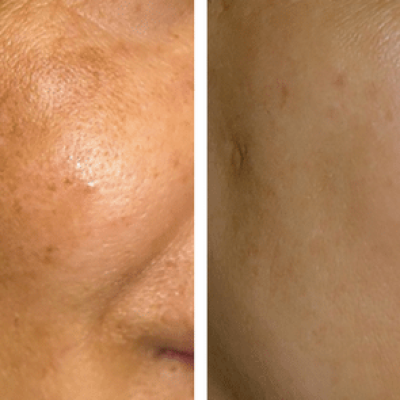Melasma
Melasma
It can affect cheeks, bridge of their nose, forehead, chin, and above their upper lip.
Sun exposure triggers melasma. The main treatment for melasma is sun protection. This means wearing sunscreen every day and reapplying the sunscreen every 2-4 hours. Is also recommended wearing a wide-brimmed hat or an umbrella when you are outside. Sunscreen alone may not give you the protection you need.
Hormones seem to trigger melasma and it is very common during pregnancy, birth control pills intake or hormonal replacement therapy.
Melasma does not cause any symptoms, but many people dislike the way melasma makes their skin look and can affect their self-esteem.

Who gets melasma?
Melasma appears on women’s skin much more often than men’s skin. Just 10% of people who get melasma are men.
People with darker skin, such as those of Latin/Hispanic, North African, African-American, Asian, Indian, Middle Eastern, and Mediterranean descent are more likely to get melasma. People who have a blood relative who had melasma also are much more likely to get melasma.
What causes melasma?
What causes melasma is not yet clear. It likely occurs when the color-making cells in the skin (melanocytes) produce too much color. People with skin of color are more prone to melasma because they have more active melanocytes than those with light skin. Common melasma triggers include:
- Sun exposure: Ultraviolet (UV) light from the sun stimulates the melanocytes. In fact, just a small amount of sun exposure can make melasma return after fading. Sun exposure is why melasma often is worse in summer. It also is the main reason why many people with melasma get it again and again.
- A change in hormones: Pregnant women often get melasma. When melasma appears in pregnant women, it is called chloasma, or the mask of pregnancy. Birth control pills and hormone replacement medicine also can trigger melasma.
- Cosmetics: Skin care products that irritate the skin may worsen melasma
How do dermatologists diagnose melasma?
Dermatologists can diagnose most patients by looking at their skin. To see how deeply the melasma penetrates the skin, your dermatologist may look at your skin under a device called dermoscope and also with a Wood’s light.
Sometimes melasma can look like another skin condition. To rule out another skin condition, your dermatologist may need to remove a small bit of skin. This procedure is called a biopsy. A dermatologist can safely and quickly perform a biopsy during an office visit.
How do dermatologists treat melasma?
Melasma can fade on its own. This often happens when a trigger is causing the melasma, such as a pregnancy or birth control pills. When the woman delivers the baby or stops taking the birth control pills, melasma can fade. For persistent cases we use bleaching cream that contain hydroquinone, arbutin, kojic acid, azelaic acid among others, depending on the severity of the pigmentation, and also creams that remove death cells, as well as procedures like chemical peels and laser.
If you notice any skin irritation after treating melasma be sure to call your dermatologist immediately
Outcome
Under a dermatologist’s care, many people with melasma have a good outcome. Melasma can be stubborn, though. It may take a couple of months of treatment to see improvement. It is important to follow your dermatologist’s advice. This ensures that you get the most benefit from treatment. It also can help avoid skin irritation and other side effects.
After your melasma clears, you may need to keep treating your skin. Your dermatologist may call this maintenance therapy. Maintenance therapy can prevent melasma from returning.
You can help prevent your melasma from returning by wearing sunscreen and a wide-brimmed hat every day.
- Wear sunscreen daily: One of the most common treatments for melasma is sun protection. Since sunlight triggers melasma, it is important to wear sunscreen every day, even on cloudy days and after swimming or sweating. Choose a sunscreen that offers broad-spectrum protection, a Sun Protection Factor (SPF) of 30 or more, and zinc oxide and/or titanium dioxide to physically limit the effects of the sun’s rays on your skin. Apply sunscreen 15 minutes before going outside and reapply at least every two hours.
- Wear a wide-brimmed hat when you’re outside: As a recent study in the journal Nature illustrates, sunscreen alone may not give you the sun protection you need. Whenever possible, seek shade and wear protective clothing in addition to applying sunscreen.
- Choose gentle skin care products: Choose skin care products that don’t sting or burn, as products that irritate the skin may worsen melasma.
- Avoid waxing: Waxing may cause skin inflammation which can worsen melasma, so it’s important to avoid waxing areas of the body affected by the condition. Ask a dermatologist about other types of hair removal that may be right for you.


Monica
Padilla
NURSE GRADUATED FROM CUC
CERTIFICATE PROGRAM IN WOUND HEALING
STAFF

Betsy
Aguirre
RECEPTION AND SALES
STAFF


Marisol
San Rafael
CERTIFIED COSMETOLOGIST
STAFF


Esmeralda
Alcaraz
CERTIFIED COSMETOLOGIST
STAFF


Lolita
Simental
RECEPTION AND SALES
STAFF
ADDRESS
Derma Health Av. Los Tules 158, Col. Díaz Ordaz Puerto Vallarta
SCHEDULE
- Mon-Fri 9:00 am a 20:00 pm
- Saturday 9:00 am a 14:00 pm
- Sunday closed
- Copyright 2023. All rights reserved.